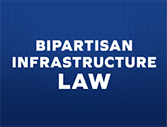Fact Sheet: Public Transportation Safety Program

BIPARTISAN INFRASTRUCTURE LAW FACT SHEET
PUBLIC TRANSPORTATION SAFETY PROGRAM
| Fiscal Year | 2022 (in millions) |
2023 (in millions) |
2024 (in millions) |
2025 (in millions) |
2026 (in millions) |
|---|---|---|---|---|---|
| State Safety Oversight | $48 | $49 | $50 | $51 | $53 |
Program Purpose:
The Bipartisan Infrastructure Law, enacted as the Infrastructure Investment and Jobs Act, continues the public transportation safety program, which includes a national public transportation safety plan, a safety certification training program, a public transportation agency safety plan, and a State Safety Oversight (SSO) program.
Statutory References:
49 U.S.C. § 5329 / IIJA § 30012
Eligible Recipients:
States with rail fixed guideway public transportation systems (rail transit systems) not under the jurisdiction of the Federal Railroad Administration are eligible to receive grants through the SSO formula program.
Eligible Activities:
Grant funds may be used for program operational and administrative expenses, including employee training activities. Recipients of funds under the urban and rural area formula programs may use not more than 0.5 percent of their formula funds to pay not more than 80 percent of the cost of participation in the public transportation safety certification training program, by an employee of a state safety oversight agency or a recipient who is directly responsible for safety oversight.
What’s Changed?
- Provides state safety oversight agencies authority to collect and analyze data and conduct risk-based inspections of rail fixed guideway transportation systems.
- Requires agency safety plans to be consistent with Centers for Disease Control and Prevention and State health authority guidelines to minimize exposure to infectious diseases.
- Requires recipients serving an urbanized area with a population of fewer than 200,000, to develop their agency safety plan in cooperation with frontline employee representatives.
- Requires recipients of section 5307 funds that serve urbanized areas with populations of 200,000 or more to undertake the following activities:
- Establish a Safety Committee, composed of representatives of frontline employees and management, that is responsible for identifying, recommending, and analyzing the effectiveness of risk-based mitigations or strategies to reduce consequences identified in the agencies’ safety risk assessment.
- Develop, and add to their agency safety plan, a risk reduction program for transit operations to improve safety by reducing the number and rates of accidents, injuries, and assaults on transit workers based on data submitted to the national transit database.
- Set risk reduction performance targets using a three-year rolling average of the data submitted by the recipient to the National Transit Database and allocate not less than 0.75 percent of their section 5307 funds to safety related projects.
- Require maintenance personnel to meet the existing safety training requirements and safety, operations, and maintenance personnel to complete de-escalation training.
